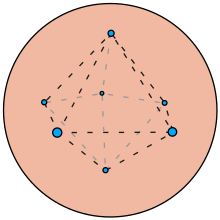
Back نموذج طومسون للذرة Arabic Modelu atómicu de Thomson AST Tomson atom modeli Azerbaijani Мадэль атама Томсана Byelorussian থমসন পরমাণু মডেল Bengali/Bangla Model atòmic de Thomson Catalan Thomsonův model atomu Czech Thomsonsches Atommodell German Ατομικό μοντέλο του σταφιδόψωμου Greek Atommodelo de Thomson Esperanto

The now obsolete plum pudding model was the first scientific model of the atom with internal structure. It was first proposed by J. J. Thomson in 1904[1] following his discovery of the electron in 1897 and subsequently rendered obsolete by Ernest Rutherford's discovery of the atomic nucleus in 1911. The model tried to account for two properties of atoms then known: that there are electrons and that atoms have no net electric charge. Logically there had to be a commensurate quantity of positive charge to balance out the negative charge of the electrons, but having no clue as to the source of this positive charge, Thomson tentatively proposed it was everywhere in the atom, the atom being in the shape of a sphere for the sake of mathematical simplicity. Following from this, Thomson imagined that the balance of electrostatic forces in the atom would distribute the electrons in a more or less even manner throughout this hypothetical sphere.[2]
Thomson attempted without success to develop a complete model that could predict any other known properties of the atom such as emission spectra or valencies. Based on experimental studies of alpha particle scattering, Ernest Rutherford developed an alternative model for the atom featuring a compact nuclear center. This model was taken up by Niels Bohr as the basis of the first quantum atom model.
Thomson's model is popularly referred to as the "plum pudding model" with the notion that the electrons are distributed with similar density as raisins in a plum pudding. Neither Thomson nor his colleagues ever used this analogy.[3] It seems to have been conceived by popular science writers to make the model accessible to the layman. The analogy is perhaps misleading because Thomson likened the sphere to a liquid rather than a solid since he thought the electrons moved around in it.[4]
- ^ "Plum Pudding Model". Universe Today. 27 August 2009. Retrieved 19 December 2015.
- ^ Thomson 1907, p. 103 "In default of exact knowledge of the nature of the way in which positive electricity occurs in the atom, we shall consider a case in which the positive electricity is distributed in the way most amenable to mathematical calculation, i.e., when it occurs as a sphere of uniform density, throughout which the corpuscles are distributed."
- ^ Hon, Giora; Goldstein, Bernard R. (6 September 2013). "J. J. Thomson's plum-pudding atomic model: The making of a scientific myth". Annalen der Physik. 525 (8–9): A129–A133. Bibcode:2013AnP...525A.129H. doi:10.1002/andp.201300732.
- ^ Letter from J. J. Thomson to Oliver Lodge dated 11 April 1904, quoted in Davis & Falconer 1997, p. 153:
"With regard to positive electrification I have been in the habit of using the crude analogy of a liquid with a certain amount of cohesion, enough to keep it from flying to bits under its own repulsion. I have however always tried to keep the physical conception of the positive electricity in the background because I have always had hopes (not yet realised) of being able to do without positive electrification as a separate entity and to replace it by some property of the corpuscles."
© MMXXIII Rich X Search. We shall prevail. All rights reserved. Rich X Search